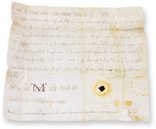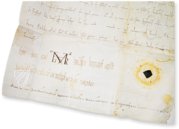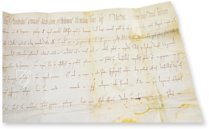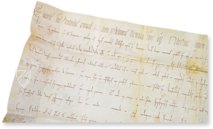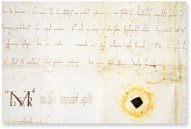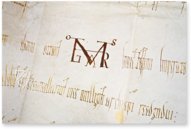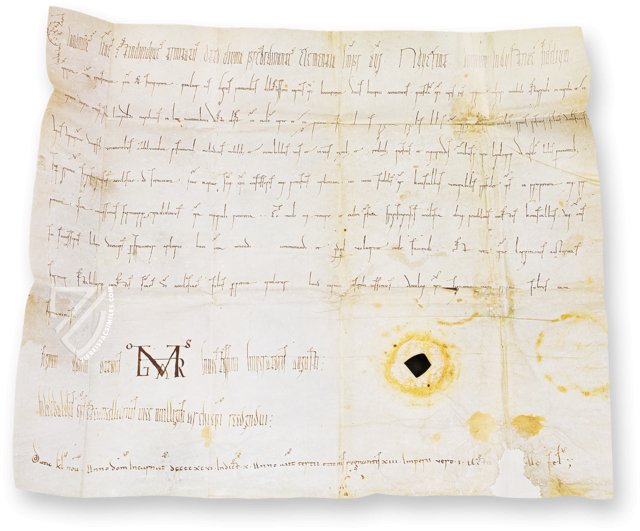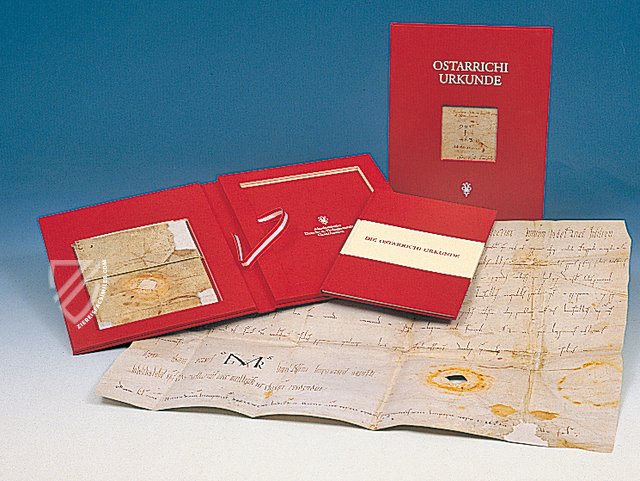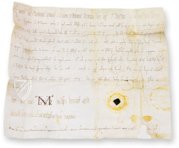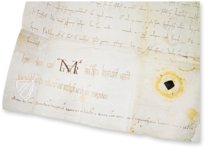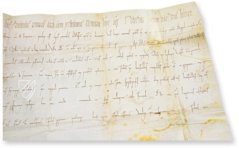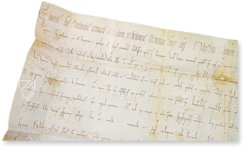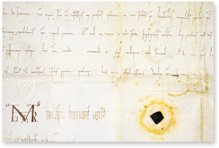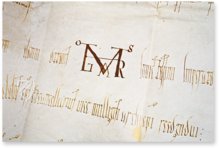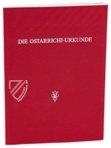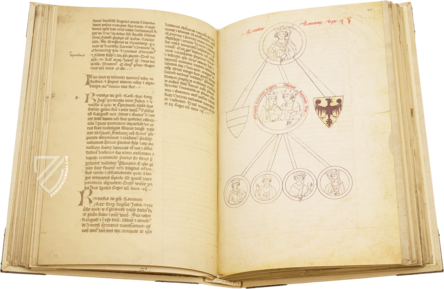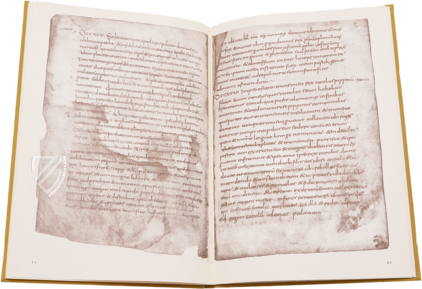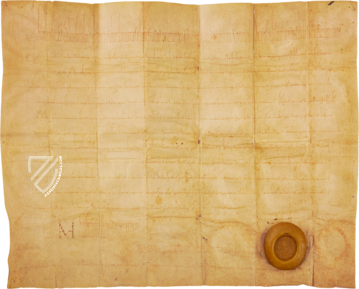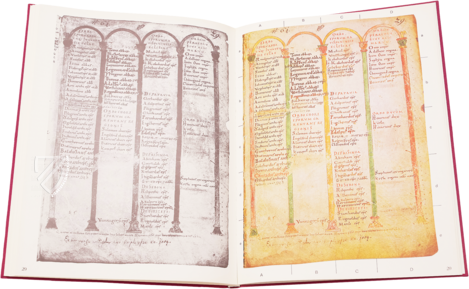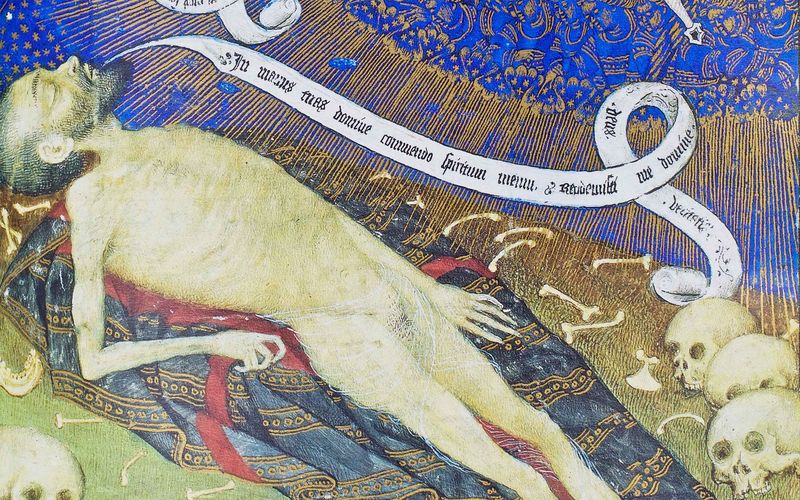Ostarrichi Document
(under 1,000€)
A document dated November 1st, 996 is the oldest surviving record of the term Ostarrîchi, an Old High German word from which is derived the modern Österreich, Latinized as “Austria”. It records what had likely been a long-established geographic term referring to the region south of the Danube: Ostarrichi. The document was primarily written in Latin and issued by Emperor Otto III as a donation of land in the region of Neuhofen an der Ybbs to Gottschalk von Hagenau, Bishop of Freising, as a fief. Aside from offering precious insights for historians into this turbulent period of Central European history, it has also been extensively studied by philologists. Kept today in the Bavarian Main State Archives in Munich, it is one of the oldest historical documents from the German-speaking lands and was celebrated by the Austrian state in 1996 with the slogan “A thousand years of Austria”.
Ostarrîchi Document
Henry the Strong (d. 1018) was the second Margrave of Austria, a territory established as a buffer zone between the lands of the Germans, Hungarians, and Poles in 976 in the as part of the gradual German reconquest and resettlement of the region. During Henry’s reign, Emperor Otto III (980–1002) sought to support these efforts by donating some lands and their corresponding incomes to Gottschalk von Hagenau, Bishop of Freising. This event is recorded on a thousand-year-old piece of parchment commonly known as the Ostarrîchi Document. However, its true historical significance is that it contains the oldest written mention of the word Ostarrîchi. A circumflex (^) was added to the word by linguists in the 19th century to make its spelling more phonetically correct, but it does not appear in the original document.
The History of Austria up to 996
Settled by humans since the Stone Age, the area of modern Austria was as early as 800 BC by a Celtic people called the Norici who were allies of the Romans. They were famous for producing Noric steel and were a major provider of weaponry to their allies before finally being incorporated into the Roman Empire in 16 BC. During the migration period, the region was temporarily settled by Goths during the 4th and 5th centuries before they moved on. The Bavarii and Slavs permanently established themselves there in the course of the 6th and 7th centuries as vassals of the Franks and mixed with the local Romano-Celtic population. Bavarians continued to spread down the Danube and up into the Alps in the following centuries, which is why they and Austrians continue to speak a similar dialect today.
Charlemagne led the Franks and Bavarians against the neighboring Avars and drove them from the area between 791 and 803 to create a series of marches between the Danube and Adriatic to protect the southeastern corner of his empire. The arrival of the Magyars in 862 initiated a century of raids and warfare that saw much of the region overrun forcing the Germans to withdraw. After the victory of Otto the Great at the Battle of Lechfeld in 955, the Magyars were driven back and the Eastern March was reestablished in 972. It was ruled beginning in 976 by Count Leopold I of Babenberg (ca. 940–994), whose family ruled Austria until they were succeeded by the famous House of Hapsburg in 1246.
Defining Ostarrîchi
Although this is the oldest written record of the work Ostarrîchi, it does not necessarily imply that Austria only came into existence a millennium ago, nor does it mean that the term Ostarrîchi was adopted overnight or originally corresponded with the historic boundaries of the country. On the contrary, it is more likely that it simply records for the first time in writing what had probably long since been a perfectly normal way of referring to the region south of the Danube. It is possible that the meaning of the term changed and evolved from referring to a specific area to becoming the word for Austria as a whole, or it could have served as shorthand for both a specific place and the region in which it is located, much as “Los Angeles” is used to refer to both the city itself and to that region of Southern California more generally.
The document only identifies it as a relatively small area, “the country called Ostarrichi” consisting of "thirty royal estates in its immediate vicinity, with cultivated and uncultivated land, meadows, pastures, forests, buildings, springs and watercourses, hunting grounds, bee meadows, fishing waters, mills, movable and immovable property, paths and impassable land, exits and entrances, yields achieved and yet to be achieved, and everything that belongs to these estates according to law and justice”. It is one of only four non-Latin words appearing in the document and the other three are Old Bavarian, and so Ostarrichi may have a similar origin as a translation of the Latin marcha orientalis or “eastern march”.
Codicology
- Alternative Titles
- Ostarrîchi-Urkunde
- Size / Format
- 1 sheet / 48.0 × 57.0 cm
- Origin
- Germany
- Date
- November 1st, 996
- Epochs
- Style
#1 Die Ostarrichi-Urkunde (Luxury Edition)
Languages: English, French, German, Spanish
(under 1,000€)
#2 Die Ostarrichi-Urkunde (Normal Edition)
Languages: English, French, German, Spanish
(under 1,000€)
- Treatises / Secular Books
- Apocalypses / Beatus
- Astronomy / Astrology
- Bestiaries
- Bibles / Gospels
- Chronicles / History / Law
- Geography / Maps
- Saints' Lives
- Islam / Oriental
- Judaism / Hebrew
- Single Leaf Collections
- Leonardo da Vinci
- Literature / Poetry
- Liturgical Manuscripts
- Medicine / Botany / Alchemy
- Music
- Mythology / Prophecies
- Psalters
- Other Religious Books
- Games / Hunting
- Private Devotion Books
- Other Genres
- Afghanistan
- Armenia
- Austria
- Belgium
- Belize
- Bosnia and Herzegovina
- China
- Colombia
- Costa Rica
- Croatia
- Cyprus
- Czech Republic
- Denmark
- Egypt
- El Salvador
- Ethiopia
- France
- Germany
- Greece
- Guatemala
- Honduras
- Hungary
- India
- Iran
- Iraq
- Israel
- Italy
- Japan
- Jordan
- Kazakhstan
- Kyrgyzstan
- Lebanon
- Liechtenstein
- Luxembourg
- Mexico
- Morocco
- Netherlands
- Palestine
- Panama
- Peru
- Poland
- Portugal
- Romania
- Russia
- Serbia
- Spain
- Sri Lanka
- Sweden
- Switzerland
- Syria
- Tajikistan
- Turkey
- Turkmenistan
- Ukraine
- United Kingdom
- United States
- Uzbekistan
- Vatican City
- A. Oosthoek, van Holkema & Warendorf
- Aboca Museum
- Ajuntament de Valencia
- Akademie Verlag
- Akademische Druck- u. Verlagsanstalt (ADEVA)
- Aldo Ausilio Editore - Bottega d’Erasmo
- Alecto Historical Editions
- Alkuin Verlag
- Almqvist & Wiksell
- Amilcare Pizzi
- Andreas & Andreas Verlagsbuchhandlung
- Archa 90
- Archiv Verlag
- Archivi Edizioni
- Arnold Verlag
- ARS
- Ars Magna
- ArtCodex
- AyN Ediciones
- Azimuth Editions
- Badenia Verlag
- Bärenreiter-Verlag
- Belser Verlag
- Belser Verlag / WK Wertkontor
- Benziger Verlag
- Bernardinum Wydawnictwo
- BiblioGemma
- Biblioteca Apostolica Vaticana (Vaticanstadt, Vaticanstadt)
- Bibliotheca Palatina Faksimile Verlag
- Bibliotheca Rara
- Boydell & Brewer
- Bramante Edizioni
- Bredius Genootschap
- Brepols Publishers
- British Library
- C. Weckesser
- Caixa Catalunya
- Canesi
- CAPSA, Ars Scriptoria
- Caratzas Brothers, Publishers
- Carus Verlag
- Casamassima Libri
- Centrum Cartographie Verlag GmbH
- Chavane Verlag
- Christian Brandstätter Verlag
- Circulo Cientifico
- Club Bibliófilo Versol
- Club du Livre
- CM Editores
- Collegium Graphicum
- Collezione Apocrifa Da Vinci
- Comissão Nacional para as Comemorações dos Descobrimentos Portugueses
- Coron Verlag
- Corvina
- CTHS
- D. S. Brewer
- Damon
- De Agostini/UTET
- De Nederlandsche Boekhandel
- De Schutter
- Deuschle & Stemmle
- Deutscher Verlag für Kunstwissenschaft
- DIAMM
- Droz
- E. Schreiber Graphische Kunstanstalten
- Ediciones Boreal
- Ediciones Grial
- Ediclube
- Edições Inapa
- Edilan
- Editalia
- Edition Deuschle
- Edition Georg Popp
- Edition Leipzig
- Edition Libri Illustri
- Editiones Reales Sitios S. L.
- Éditions de l'Oiseau Lyre
- Editions Medicina Rara
- Editorial Casariego
- Editorial Mintzoa
- Editrice Antenore
- Editrice Velar
- Edizioni Edison
- Egeria, S.L.
- Eikon Editores
- Electa
- Emery Walker Limited
- Enciclopèdia Catalana
- Eos-Verlag
- Ephesus Publishing
- Ernst Battenberg
- Eugrammia Press
- Extraordinary Editions
- Fackelverlag
- Facsimila Art & Edition
- Facsimile Editions Ltd.
- Facsimilia Art & Edition Ebert KG
- Faksimile Verlag
- Feuermann Verlag
- Folger Shakespeare Library
- Franco Cosimo Panini Editore
- Friedrich Wittig Verlag
- Fundación Hullera Vasco-Leonesa
- G. Braziller
- Gabriele Mazzotta Editore
- Gebr. Mann Verlag
- Gesellschaft für graphische Industrie
- Getty Research Institute
- Giovanni Domenico de Rossi
- Giunti Editore
- Graffiti
- Grafica European Center of Fine Arts
- Guido Pressler
- Guillermo Blazquez
- Gustav Kiepenheuer
- H. N. Abrams
- Harrassowitz
- Harvard University Press
- Helikon
- Hendrickson Publishers
- Henning Oppermann
- Herder Verlag
- Hes & De Graaf Publishers
- Hoepli
- Holbein-Verlag
- Houghton Library
- Hugo Schmidt Verlag
- Idion Verlag
- Il Bulino, edizioni d'arte
- ILte
- Imago
- Insel Verlag
- Insel-Verlag Anton Kippenberger
- Instituto de Estudios Altoaragoneses
- Instituto Nacional de Antropología e Historia
- Istituto dell'Enciclopedia Italiana - Treccani
- Istituto Ellenico di Studi Bizantini e Postbizantini
- Istituto Geografico De Agostini
- Istituto Poligrafico e Zecca dello Stato
- Italarte Art Establishments
- Jan Thorbecke Verlag
- Johnson Reprint Corporation
- Josef Stocker
- Josef Stocker-Schmid
- Jugoslavija
- Karl W. Hiersemann
- Kasper Straube
- Kaydeda Ediciones
- Kindler Verlag / Coron Verlag
- Kodansha International Ltd.
- Konrad Kölbl Verlag
- Kurt Wolff Verlag
- La Liberia dello Stato
- La Linea Editrice
- La Meta Editore
- Lambert Schneider
- Landeskreditbank Baden-Württemberg
- Leo S. Olschki
- Les Incunables
- Liber Artis
- Library of Congress
- Libreria Musicale Italiana
- Lichtdruck
- Lito Immagine Editore
- Lumen Artis
- Lund Humphries
- M. Moleiro Editor
- Maison des Sciences de l'homme et de la société de Poitiers
- Manuscriptum
- Martinus Nijhoff
- Maruzen-Yushodo Co. Ltd.
- MASA
- Massada Publishers
- McGraw-Hill
- Metropolitan Museum of Art
- Militos
- Millennium Liber
- Müller & Schindler
- Nahar - Stavit
- Nahar and Steimatzky
- National Library of Wales
- Neri Pozza
- Nova Charta
- Oceanum Verlag
- Odeon
- Orbis Mediaevalis
- Orbis Pictus
- Österreichische Staatsdruckerei
- Oxford University Press
- Pageant Books
- Parzellers Buchverlag
- Patrimonio Ediciones
- Pattloch Verlag
- PIAF
- Pieper Verlag
- Plon-Nourrit et cie
- Poligrafiche Bolis
- Presses Universitaires de Strasbourg
- Prestel Verlag
- Princeton University Press
- Prisma Verlag
- Priuli & Verlucca, editori
- Pro Sport Verlag
- Propyläen Verlag
- Pytheas Books
- Quaternio Verlag Luzern
- Reales Sitios
- Recht-Verlag
- Reichert Verlag
- Reichsdruckerei
- Reprint Verlag
- Riehn & Reusch
- Roberto Vattori Editore
- Rosenkilde and Bagger
- Roxburghe Club
- Salerno Editrice
- Saltellus Press
- Sandoz
- Sarajevo Svjetlost
- Schöck ArtPrint Kft.
- Schulsinger Brothers
- Scolar Press
- Scrinium
- Scripta Maneant
- Scriptorium
- Shazar
- Siloé, arte y bibliofilia
- SISMEL - Edizioni del Galluzzo
- Sociedad Mexicana de Antropología
- Société des Bibliophiles & Iconophiles de Belgique
- Soncin Publishing
- Sorli Ediciones
- Stainer and Bell
- Studer
- Styria Verlag
- Sumptibus Pragopress
- Szegedi Tudomànyegyetem
- Taberna Libraria
- Tarshish Books
- Taschen
- Tempus Libri
- Testimonio Compañía Editorial
- Thames and Hudson
- The Clear Vue Publishing Partnership Limited
- The Facsimile Codex
- The Folio Society
- The Marquess of Normanby
- The Richard III and Yorkist History Trust
- Tip.Le.Co
- TouchArt
- TREC Publishing House
- TRI Publishing Co.
- Trident Editore
- Tuliba Collection
- Typis Regiae Officinae Polygraphicae
- Union Verlag Berlin
- Universidad de Granada
- University of California Press
- University of Chicago Press
- Urs Graf
- Vallecchi
- Van Wijnen
- VCH, Acta Humaniora
- VDI Verlag
- VEB Deutscher Verlag für Musik
- Verlag Anton Pustet / Andreas Verlag
- Verlag Bibliophile Drucke Josef Stocker
- Verlag der Münchner Drucke
- Verlag für Regionalgeschichte
- Verlag Styria
- Vicent Garcia Editores
- W. Turnowski Ltd.
- W. Turnowsky
- Waanders Printers
- Wiener Mechitharisten-Congregation (Wien, Österreich)
- Wissenschaftliche Buchgesellschaft
- Wissenschaftliche Verlagsgesellschaft
- Wydawnictwo Dolnoslaskie
- Xuntanza Editorial
- Zakład Narodowy
- Zollikofer AG




